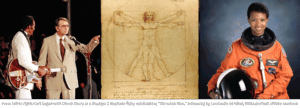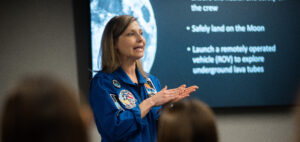
When most people think of STEM, they picture chemists in white lab coats, engineers sketching blueprints, or astronauts floating weightlessly in space. For a long time, I did too.
As a kid, I dreamed of becoming an astronaut — not only because the idea of exploring the cosmos excited me, but because I wanted to contribute to discovery and the advancement of humankind. But as I grew older and realized I had a stronger passion for the arts than the sciences, I reluctantly set aside my childhood dream and pursued a degree in English.
 But then, something wonderful happened: my dream found its way back to me. Upon graduating, I started a job as a communications professional for Challenger Center, a STEM education organization dedicated to inspiring the next generation of explorers. In this role, I get to cover key STEM and space-related events for our digital platforms, collaborate with passionate educators on social media, and amplify Challenger Center’s mission so more students can experience our programs. I hadn’t become an astronaut, but I was helping others see themselves in the stars. My humanities background wasn’t a detour; it was my unique path to making a difference in STEM.
But then, something wonderful happened: my dream found its way back to me. Upon graduating, I started a job as a communications professional for Challenger Center, a STEM education organization dedicated to inspiring the next generation of explorers. In this role, I get to cover key STEM and space-related events for our digital platforms, collaborate with passionate educators on social media, and amplify Challenger Center’s mission so more students can experience our programs. I hadn’t become an astronaut, but I was helping others see themselves in the stars. My humanities background wasn’t a detour; it was my unique path to making a difference in STEM.
My story is just one part of a broader misconception that you have to be a scientist to belong in STEM. But the truth is, these fields thrive when people from all backgrounds, including those in the humanities, are part of the conversation.
Why STEM Needs the Humanities
The humanities disciplines, like literature, history, philosophy, and the arts, help us understand what it means to be human: our values, choices, emotions, and motivations. At first glance, STEM might seem like the opposite of this; it’s rooted in logic, data, and experimentation rather than interpretation or creativity. But in practice, the humanities and STEM don’t stand in opposition. They enrich and strengthen one another.
Both depend on curiosity, critical thinking, and problem-solving. In fact, possessing durable skills like communication, empathy, and storytelling is essential to solving scientific problems. For example:
- Evocative writing helps scientists communicate complex ideas in a digestible way
- Design and psychology shape user-centric engineering
- Empathy and ethics guide responsible innovation (e.g., AI, biotechnology)
Just look at figures who’ve bridged both worlds: Carl Sagan, who made the cosmos accessible through his poetic storytelling; Leonardo da Vinci, who merged art and engineering to imagine the future and invent the impossible; or Mae Jemison, the first woman of color in space, who earned degrees in both the arts and sciences and has long championed their integration. STEM’s greatest advancements often come from those who can think like scientists and storytellers.

The thinkers who integrate STEM and humanities aren’t just historical. Consider the countless NASA communication specialists who bring space exploration to life for the public. The skills needed to excel in this role — reading, writing, speaking, and digital communication — aren’t typically associated with space exploration, yet they’re vital to its success. They build public will to support the ambitious goals of human spaceflight and exploring beyond our own planet.
Another example of these kinds of integrated thinkers hits very close to home: the Flight Directors at your local Challenger Learning Center. Leading each team of students through their Mission, a Flight Director’s role is both that of STEM educator and storyteller. They must be able to help a sixth grader with the equations needed to navigate a lunar lander AND clearly explain the day’s mission so every student can imagine themselves in their role. They need to answer questions about plant growth for the biology team AND convincingly act alarmed when an “emergency” threatens to derail the mission. They are responsible for the learning, but also keeping the spell of the immersive experience alive.

Challenger Center’s commitment to bridging the humanities and STEM plays out in our programs as well. Every Mission has Communications Officers who relay critical information to their crewmates. They also inform the public — via press releases and social media — about the Mission in real time. Roles like these teach kids that everyone belongs in STEM, no matter their skill set or background. By highlighting jobs like this, we show students that STEM has space for everyone; even the student who prefers writing stories to building model rockets has an important part to play in exploration and discovery.
How to Foster “STEM for Everyone”
Educators and parents can help students see that STEM isn’t just about equations, it’s about curiosity and creativity. Here are a few ways to bring that idea to life:
- Integrate storytelling and ethics into STEM lessons. Ask students not only how something works, but why it matters.
- Encourage cross-disciplinary projects. Pair coding with art, robotics with design, or biology with social studies.
- Use design thinking. Let students brainstorm solutions to real-world problems that build their skills in both empathy and experimentation.
At Challenger Center, we employ strategies like these in our programming with the goal of making STEM relatable, accessible, and human.
When I first joined Challenger Center, I couldn’t believe my luck — I thought that it was pure happenstance that I, an English major, found my way back into the world of space. However, I now realize that there are a plethora of opportunities for those with skills like mine to be involved in STEM. Because STEM and the humanities aren’t opposites, they’re partners.
As Carl Sagan once said, “Science is not only compatible with spirituality; it is a profound source of spirituality.” I’d argue the same is true for STEM and the humanities. When we bring both together, we not only understand the stars, we also understand ourselves.
